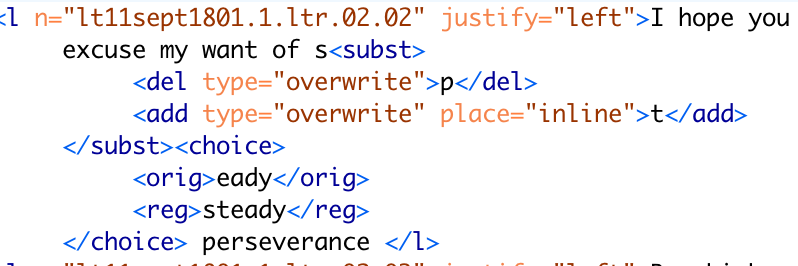Since this is my first semester working with the Blake Archive—and all of my previous interaction with Blake’s work has consisted of reading his poems in relative isolation in my house—my main concern has been trying to understand Blake’s handwriting and figure out how the XML tag set works. More specifically, I have been trying to identify the places in the text where Blake scribbles over words or crosses them out. In some instances, the word underneath may be legible, but as a newcomer to reading Blake’s original manuscripts, I have trouble asserting anything with authority. Similarly, it has been difficult deciphering the way in which Blake renders some individual letters. For example, his “s” often looks like an “f” and his periods sometimes look like commas. I realize that recognizing things quickly is an issue of experience, and I do find that copyediting the XML against the original images of the letters is very helpful. The process of working backwards—looking at the XML, then the handwriting—seems far more useful than trying to look at the letter and blindly translate Blake’s handwriting.
I am currently copyediting a letter from September 11, 1801, in which Blake writes to Mr. Butts in London. This letter seems fairly straightforward, but I am still trying to understand how overstrikes work, and how editors decide what constitutes an overstrike, as opposed to an overwrite. For example, as in the image below, I have learned that the “t” written over “p” is an overstrike because the “p” is a piece of text that has been deleted by a line drawn through it.

Of course, this sounds rudimentary, but as a beginner, it is difficult to decipher whether a moment of sloppiness or indecision in the text is an error that should be reflected in the XML, or is just the product of a slip of the pen or roll of the wrist. How do we know if the letter’s rendering is significant, or if it is negligible and should not be noted because it is simply a characteristic of Blake’s handwriting? For example, see “spectres” below. The word appears frustrated, but has not been deleted or overwritten by any new text, so it has been transcribed directly.

In contrast, the nugget of transcription for the first image above shows how to make a substitution for a single letter that has been overwritten. The XML includes the original word (with the “p”), and Blake’s correction (with the “t” written over the “p”). In general, the logic of the tag set makes sense to me, even though I am still piecing together how it works. So, in this instance, the “p” is overwritten with a “t” within the line (“inline”) and the word “speady” is substituted” for “steady.”

I might add that there is a nice parallel between the intentionality of Blake’s self-editing (strikeouts, scratches, wash, erasure) and the editorial decisions that are made with XML. The transcriber is trying to correctly render Blake’s self-editing, and Blake has tried to correctly render his own choice and substitution. The mirror effect is implicit and logical, which I find strangely satisfying. So far, I have enjoyed my introduction to the archive’s processes and am looking forward to the day when I can definitively say that an “s” is an “s.”
